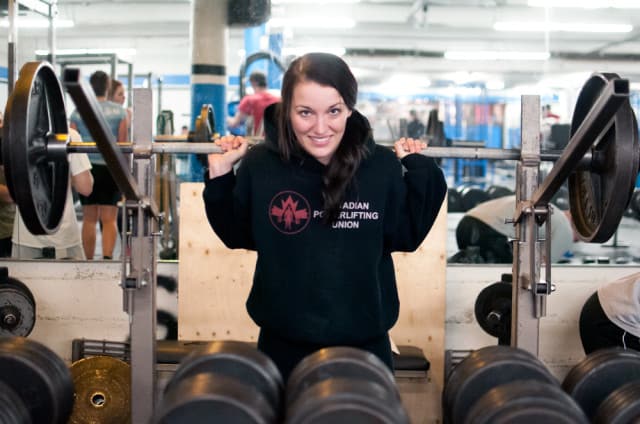
Robyn Pearce is training to show off her strength at the Junior World Powerlifting Championships this summer.
Walking around campus, 20-year-old Robyn Pearce blends in with the crowds of students, but meet her at the gym and you’ll soon see why Pearce is a nationally recognized powerhouse.
She holds a national record in powerlifting, a strength sport where competitors vie against one another to see who can lift the most combined weight in three separate events — the bench press, the deadlift and the squat. A competitor’s score is the sum of their heaviest lift in each event.
Pearce has been lifting competitively for a year, and only started because she was looking for summer employment.
“I applied for a job with an organizing committee for the World Championship that was held in Moose Jaw a couple of summers ago,” Pearce said. “I just randomly applied and they hired me.
“I had no idea what the sport was and after the summer went by and I saw the competition, I thought it was really cool and I wanted to start.”
That was in the summer of 2011. Pearce started going to the gym more often and it didn’t take long before she was following a training program specific to powerlifters. She participated in her first competitive powerlifting event last February.
“From then on I went to nationals and slowly just kind of found my groove,” said Pearce who competes in the Junior age division, which encompasses athletes aged 19 to 23.
At nationals last year she set a new record for deadlift in the Junior 52-kilogram weight class. Starting in a bent position, she hoisted 92 kilograms off the ground and brought her body to an upright position. She also set the total-weight record in her class and age division with 212 kilograms.
Since becoming a national champion, Pearce has joined forces with a handful of other powerlifting enthusiasts in Saskatoon to create Saskatoon Barbell. The club is a group within the Saskatchewan Powerlifting Association and includes seven U of S students and faculty members.
Pearce says the group is currently gearing up for Canada’s national competition in Richmond, B.C. March 18-24.
“It’s just a big passion of mine. I love doing it. It’s what I spend most of my free time doing,” Pearce said. She joked that her ideal date was spending time in the gym with her boyfriend, who also powerlifts.
Unlike weight lifting, which includes the snatch and clean-and-jerk events, powerlifting is not an Olympic sport — though competitive powerlifters are tested by the World Anti-Doping Agency, the same drug testing agency used by the Olympic Games.
The lack of mainstream attention that powerlifting gets means that even those who compete for Canada internationally almost never receive any public or private funding.
“If you’re really good and basically World Champion multiple times in a row, you’ll start to get money,” Pearce said. But she stressed that to get started “you have to love it enough to not want to base it off money.”
Although you would never know now, Pearce used to have to force herself to go to the gym, just like most university students. She now trains three times a week, sometimes more than two hours per session. Pearce says the focus of powerlifting has made the difference for her.
“My first year of university it was all, ‘I’m totally going to go to the gym,’ and I never went because I didn’t know what I was doing and I would just go on the treadmill and not feel very productive.
“But with powerlifting you set new goals for yourself and it’s like you go to the gym with a purpose. Now I love going to the gym, it’s a complete 180.”
Even though Pearce became a national champion at classic lifting last year, she has decided to switch to the equipped lifting style. Equipped includes the use of braces, belts and shirts that aid the lifter in stabilizing their body and getting the most out of their strength. Those who compete in classic powerlifting do not use extra equipment.
Despite the switch, Pearce still expects to qualify for the Junior World Powerlifting Championships in Killeen, Texas this summer.
“I should get a place on Team Canada because there aren’t a lot of equipped women competitors in Canada,” Pearce said. She will compete in the 57-kilogram weight class in this year’s competitions.
—
Photo: Raisa Pezderic/The Sheaf